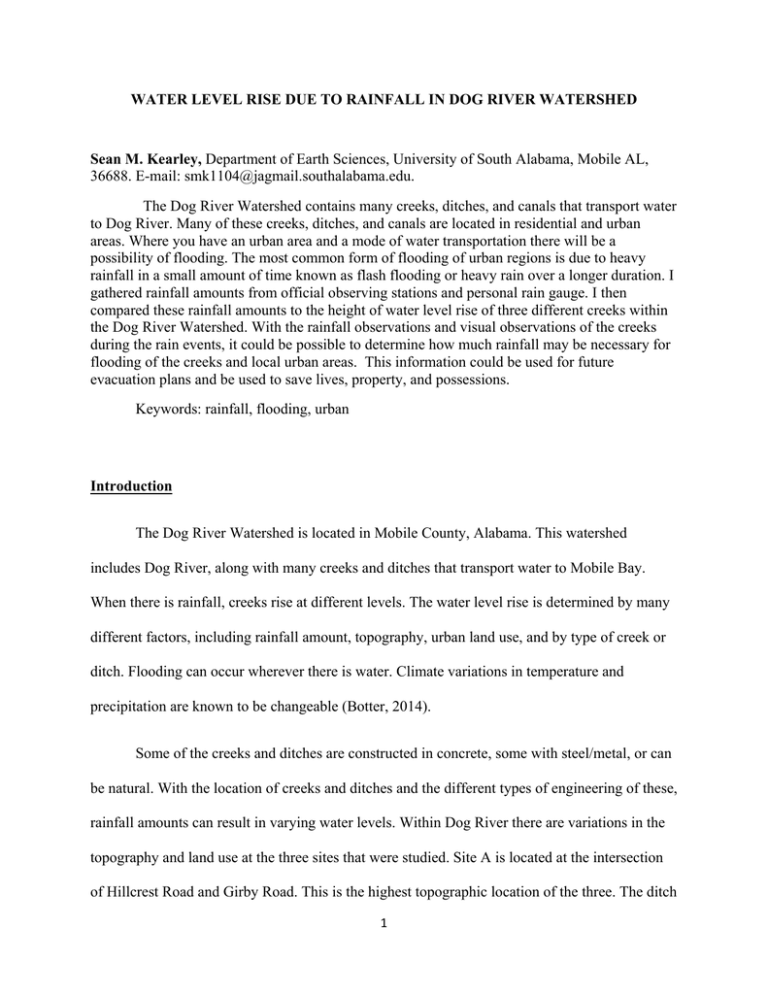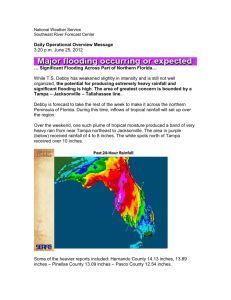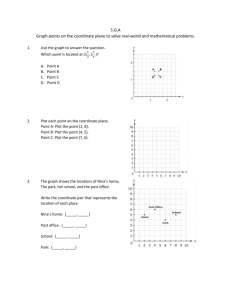WATER LEVEL RISE DUE TO RAINFALL IN DOG RIVER WATERSHED 36688.
advertisement

WATER LEVEL RISE DUE TO RAINFALL IN DOG RIVER WATERSHED Sean M. Kearley, Department of Earth Sciences, University of South Alabama, Mobile AL, 36688. E-mail: smk1104@jagmail.southalabama.edu. The Dog River Watershed contains many creeks, ditches, and canals that transport water to Dog River. Many of these creeks, ditches, and canals are located in residential and urban areas. Where you have an urban area and a mode of water transportation there will be a possibility of flooding. The most common form of flooding of urban regions is due to heavy rainfall in a small amount of time known as flash flooding or heavy rain over a longer duration. I gathered rainfall amounts from official observing stations and personal rain gauge. I then compared these rainfall amounts to the height of water level rise of three different creeks within the Dog River Watershed. With the rainfall observations and visual observations of the creeks during the rain events, it could be possible to determine how much rainfall may be necessary for flooding of the creeks and local urban areas. This information could be used for future evacuation plans and be used to save lives, property, and possessions. Keywords: rainfall, flooding, urban Introduction The Dog River Watershed is located in Mobile County, Alabama. This watershed includes Dog River, along with many creeks and ditches that transport water to Mobile Bay. When there is rainfall, creeks rise at different levels. The water level rise is determined by many different factors, including rainfall amount, topography, urban land use, and by type of creek or ditch. Flooding can occur wherever there is water. Climate variations in temperature and precipitation are known to be changeable (Botter, 2014). Some of the creeks and ditches are constructed in concrete, some with steel/metal, or can be natural. With the location of creeks and ditches and the different types of engineering of these, rainfall amounts can result in varying water levels. Within Dog River there are variations in the topography and land use at the three sites that were studied. Site A is located at the intersection of Hillcrest Road and Girby Road. This is the highest topographic location of the three. The ditch 1 where measurements were taken was located in a valley, in between two hills. The land use in this location is a mix of wooded, residential, and urban. Site B is Rabbit Creek, located under Todd Acres Road near Mobile Commerce Park. Rabbit Creek is natural, without concrete or manmade structures except for the bridge going over the creek. This area was the most wooded and least urban landscape of the three study areas. Site C is Montlimar Canal, located near the intersection of Azela Road and Halls Mill Road. This study area was the most urban of the three with many business’ and residential housing. The topography here was flat. Variability of rain depths has varying effects and causes uncertainty in water level rise due to the design of the creeks when related to topography and different forms of urban land use (Mutzner, 1991). In the gulf coast region, along with the Southeast coast, the highest rainfall intensities usually occur during the summertime thunderstorms (Lecce, 2005). The time of study for this research was during the spring. The rainfall events were sporadic and tough to make concrete conclusion with, but there was one week of much higher rainfall amounts that did help to show rain’s effects on the local creeks and ditches within Dog River Watershed. Too high of water levels lead to flooding of the creek-banks and can result in the destruction of possessions, property, houses, or could kill you. These are the most important reasons for being aware of the potential of creek/ditch flooding. 2 C A B Figure 1. Location of study sites in the Dog River Watershed Research Question When it rains a certain amount, how high does the water level of creeks/ditches rise and how much rain can cause flooding of these locations? The significance of this is to help try to protect life and property from the threats of flooding by trying to determine water level rise compared to the rainfall amounts. If an exact amount of rain in a certain amount of time is 3 determined to cause flooding, residents and business owners living near creeks and ditches could have more time to prepare to protect themselves but also not worry about unnecessary preparations for lesser rain amounts even though a Flood Warning may be in effect but not affecting you. Methods To answer this question several methods of data collection were used. Depending on the task, data from a single gauge or network of gauges was required. This is known as “regionalization” by hydrologists (Schilling, 1991). The first step was to find three different creek/ditch locations to observe. At these 3 sites there are bridges with pylons or concrete wall. Using chalk, lines of measurement by the foot were drawn on to the pylons at the site to easily show visually the high water marks after rain events. A vertical line was drawn to help determine to the inch, how high water level rose during a single rain event. A measuring tape will be used to accurately draw the horizontal lines. If and when the chalk marks are washed away, new markings at the same location will be made if possible. Rainfall amounts were gathered from the closest official rain gauge stations such as NOAAs at the NWS, CoCORaHS observers, and at Brookley Field to compare rainfall amounts in different parts of Dog River Watershed to creek/ditch water level measurements and observations. A rain gauge was also located at Michael David’s residence at the Grove apartments on the campus of South Alabama. It would have helped to have rain gauges at each cite but I could not guarantee the safety/security of my personal rain gauges because the possibility they get washed away, broken, or stolen. Repeat photography was used to show the differences in water level to differences in rain amount. Photos were taken at the beginning to 4 show my baseline water level that’s used to determine event height and more photos were taken after rainfall events. Figure 2. Before and after photo at Site C. Results of heavy rain that fell April 12th and 13th 2015. Red line shows the location of the 6 foot mark on bridge pylon. Results This research was done over a period of 45 days from March 2nd, 2015 to April 15th, 2015. Within this timeframe, there were 18 days with measureable rainfall with only two of the days receiving rainfall amounts of over one inch. The heavy rainfall event on April 12th and 13th of 2015 provided the best and most visually appealing results to the topic researched. There were 5 other light, prolonged rainfalls but the light, prolonged events do not produce much in the way of visual results. Slight rises in inches occurred with the light rain events. This was opposite during the heavy rain event on April 12th and 13th. Site A experienced a maximum water level rise of at least 5 feet and did cause flooding of Hillcrest Road. Site B, natural banked creek, experienced a maximum water level rise of 7 feet. Site C experienced a water level rise of 5 feet 1 inch. The rainfall amounts were taken over a 24 hour period, beginning at 7:00am April 12th and ending 7:00am April 13th. Mike’s gauge received 8 inches. Downtown Mobile received 2.9 inches (NWS, 2015). NWS Mobile received 8.79 inches (NWS, 2015). Brookley Field received 3.2 inches (NWS, 2015). Within Dog River watershed rainfall amounts were variable during the April 12th and 13th event. From 8:20am the 12th to 9:00am the 13th , an observation 4.3 miles west-northwest of Tillmans Corner received 11.01 inches(CoCoRaHS, 2015). A location 8 miles to the south-southeast of Theodore, received 3.25 inches from 8:00am the 12th to 8:00am the 13th (CoCoRaHS, 2015). A site 7.4 miles west of Mobile recorded 7.79 inches from 7:02am the 12th to 7:36am the 13th (CoCoRaHS, 2015). The second heaviest event occurred on March 9th and 10th. The rainfall amounts with this event were more evenly distributed. Mike’s gauge received 2.1 inches in 31 hours from 7am the 9th to noon the 10th. The CocoRaHS observer 4.3 mile west-northwest of Tillimans Corner recorded 1.66 inches from 9am the 9th to 8:45am the 10th (CoCoRaHS, 2015). An observer 11.4 miles west-southwest of Mobile, near Theodore, received 1.4 inches between 5:45am the 9th to 5:45am the 10th (CoCoRaHS, 2015). An observer 7.4 miles west of Mobile recorded 1.74 inches from 7am the 9th to 8:35 the 10th (CoCoRaHS, 2015). The observer 8 miles south-southeast of Theodore received 1.55 inches from 8am on the 9th to 8am on the 10th (CoCoRaHS, 2015). The 6 water level at Site B, Rabbit Creek, during this event was estimated to be 3 feet 4 inches. The other two field sites had not fully been established for this event. 10 8 6 4 2 0 A B C Figure 3. Bar graph of heavy rain event from April 12th and 13th. Blue is rainfall amount in inches and brown is water level rise in feet. Conclusion The main objective of this project was to observe water level rise and height at 3 creeks/ditches within the Dog River Watershed compared to rainfall amounts. The lack of heavy rainfall events made it difficult to get repetition of results. My knowledge of rain’s impact on creeks and ditches allows me to arrive at the conclusion that rainfall events equal to those on April 12th and 13th would produce similar results if conditions prior to, duration of rain, and amount of rain were to be similar. When referring to Figure 3 (above), you see that site B rose higher than Sites A and C. Site B was the most wooded, natural growth landscape and the least urban which should promote a lesser water level rise. The reason for this difference was the 7 heavier rainfall totals that occurred near Tillmans Corner, which is located closer to the subwatershed and up-water from Site B. These observations will allow for better warning time for flood preparations and/or evacuations which could save money, valuables, and lives. Acknowledgements Michael David for rain gauge and rainfall measurements Mr. Stutsman for map of Dog River Watershed Dr. Fearn for method, graph, and everything she does to help Works Cited Botter, G. "Flow regime shifts in the Little Piney creek (US)." Advances in Water Resources, 2014: 44-54. CoCoRaHS. n.d. www.cocorahs.org/ViewData/StateDailyPrecipReports.aspx?state=AL (accessed April 30, 2015). Mutzner, Heinz. "The significance of areal rainfall distribution for flows from a very small urban drainage catchment." Atmospheric Research, 1991: 99-107. National Weather Service . n.d. www.srh.noaa.gov/mob/?n=climate (accessed March 12, 2015). Schilling, Wolfgang. "Rainfall data for urban hydrology: what do we need?" Atmospheric Research, 1991: 5-21. Scott A. Lecce, Patrick P. Pease, Paul A Gares, Jingyu Wang. "Seasonal controls on sediment delievery in a small coastal plain watershed, North Carolina, USA." Geomorphology, 2006: 246-260. 8





